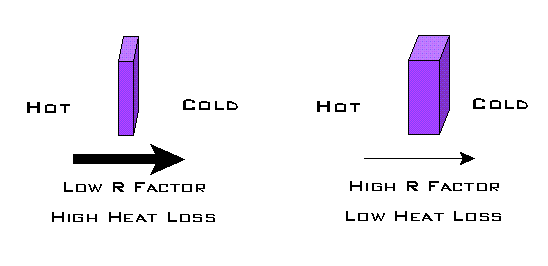The Energy Story
The Energy Problem
The Energy Solution
Conserving
Electricity
Appliance
Efficiency
Heating
Conservation
Renewable
Energy
|

|
Heating
Conservation
|
|
By using
our knowledge of the three methods of transferring heat, we
can see how to save on our heating and cooling energy bills.
|
Saving
Heat Energy
Conduction
|
|
One way
that heat can escape from your house is by conduction through
the walls, ceilings, and windows. Most walls and ceilings
contain material to stop this heat conduction called insulation.
There are many types of insulation, depending on the location
in the house and the degree of insulation that is desired.
One popular measure of the effectiveness of insulation is
called the "R" factor. The R factor is a measure
of the resistance of the insulation to the transfer of heat.
The higher the R factor, the more resistance, and the less
heat that is transferred. The materials and labor to install
insulation cost money, so depending on the size and location
of the house, there is an R factor that is the most cost efficient.
Most older homes were built when the cost of energy was lower
and the insulation was more expensive for the same R factor
rating. Therefore, it may save you both energy and money to
invest in more insulation in your walls and ceilings.

The
same concept of insulation applies to windows. Typically,
the "insulation" that is used is air, since regular
insulation is a bit hard to see through. The air is trapped
between two panes of glass. These double paned insulated windows
significantly decrease the loss of heat through the windows.
|
|
Convection
|
|
The main
fluid available to transfer heat by convection in your home
is air. Air can come in and out of your home in many different
places: cracks around your windows, cracks under the doors,
places where wires or pipes come into the house, and even
from the electrical outlets. There is an amazing number of
different products available to keep this air flow from occurring
including: strip insulation for around windows; door stops
for under door openings; caulking for around windows, pipes,
and wires; and small pieces of insulation that fit behind
your electrical outlet plates. Often you can find the places
that need to be insulated by just placing your hand in front
of the crack or electrical outlet. If you feel a cold draft
during the winter, for example, you probably could save energy
and money by stopping this air flow.
|
|
Radiation
|
|
No matter
what you do, some heat energy will radiate away from your
house on a cold night. The lower the outside temperature of
your house, the less energy that will be radiated. Therefore,
the insulation you use to prevent conduction will also cut
down on the losses from radiation.
The most
obvious way to save energy and heat by using your understanding
of radiation heat transfer is to close your drapes at night,
and open them during the day. This will allow the sunlight
to enter and heat the house during the day, and keep the warm
insides of your house from radiating heat away at night. Of
course, the drapes also provide insulation and prevent heat
loss from conduction.
|
|
|
|
|